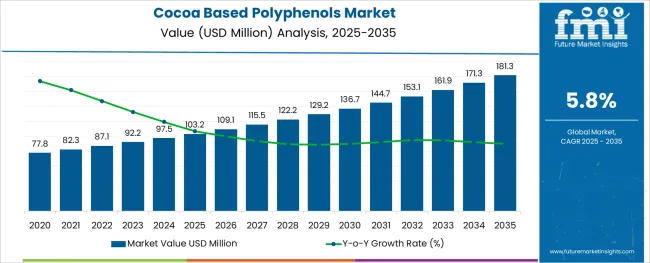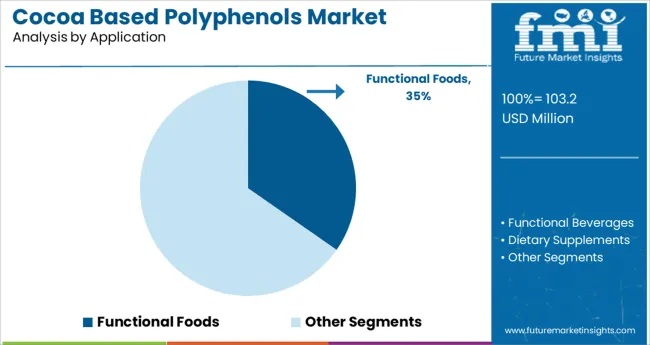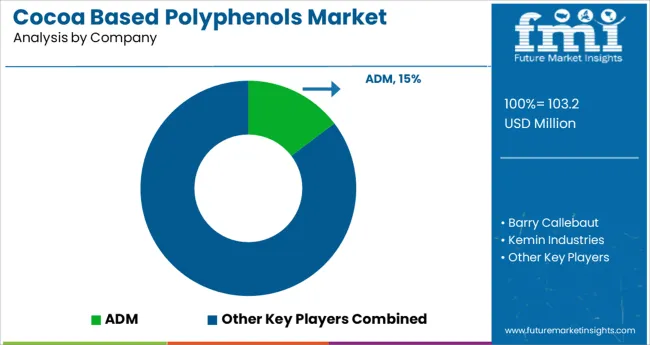The Cocoa Based Polyphenols Market is estimated to be valued at USD 103.2 million in 2025 and is projected to reach USD 181.3 million by 2035, registering a compound annual growth rate (CAGR) of 5.8% over the forecast period.

The cocoa based polyphenols market is witnessing notable momentum due to increasing consumer preference for functional ingredients that support cardiovascular health, metabolic regulation, and anti-inflammatory benefits. The antioxidant-rich profile of cocoa polyphenols is gaining prominence within food, beverage, and nutraceutical formulations, driven by rising demand for natural compounds with clinically supported health claims.
Manufacturers are incorporating cocoa extracts into a variety of wellness-oriented products, supported by advancements in microencapsulation and bioavailability enhancement techniques. Regulatory bodies in key markets are endorsing the use of polyphenol-rich ingredients in functional products, further legitimizing their role in preventive health.
As research continues to validate the link between polyphenols and chronic disease mitigation, demand is expected to grow in tandem with consumer interest in longevity and plant-based health interventions. Future market growth will be supported by sustained product innovation, strategic ingredient positioning, and increasing availability of high-purity cocoa polyphenol extracts for diversified application formats.
The market is segmented by Application and region. By Application, the market is divided into Functional Foods, Functional Beverages, Dietary Supplements, and Others. Regionally, the market is classified into North America, Latin America, Western Europe, Eastern Europe, Balkan & Baltic Countries, Russia & Belarus, Central Asia, East Asia, South Asia & Pacific, and the Middle East & Africa.
The market is segmented by Application and region. By Application, the market is divided into Functional Foods, Functional Beverages, Dietary Supplements, and Others. Regionally, the market is classified into North America, Latin America, Western Europe, Eastern Europe, Balkan & Baltic Countries, Russia & Belarus, Central Asia, East Asia, South Asia & Pacific, and the Middle East & Africa.

The functional foods segment is anticipated to hold a 34.7% revenue share in the cocoa based polyphenols market by 2025, marking it as the leading application category. This dominance is being driven by the expanding role of food as a delivery system for bioactive compounds that support health and wellness.
Cocoa polyphenols are being widely utilized in cereals, bars, dairy alternatives, and baked goods, where they provide antioxidant functionality along with flavor enhancement. Food manufacturers are responding to clean label trends and increasing demand for natural, plant-derived additives that deliver quantifiable health benefits.
Furthermore, clinical evidence supporting the role of cocoa flavonoids in cardiovascular function, blood sugar modulation, and gut microbiome support has strengthened their inclusion in health-focused food portfolios. The ability to combine indulgence with function is also proving critical in consumer acceptance, reinforcing the position of functional foods as the primary growth driver within the cocoa polyphenols application landscape.
Over the last few decades, according to the global market study report on cocoa-based polyphenol products, the market continued at a very slow pace until 2020. Unawareness about the benefits of the product and unfamiliarity with its uses had limited the cocoa-based polyphenol market growth only within traditional cocoa production regions.
However, the demand for cocoa-based polyphenols increased during the pandemic as people's immunity and general well-being came under increasing scrutiny. The global cocoa-based polyphenols market share is poised to experience an upward trajectory in the coming days, thanks to ongoing Research and Development helping companies win over customers.
The cocoa-based polyphenols market future trends are anticipated to be driven by growing people's busy lives and growing awareness of the health advantages of these nutrient-rich foods. Recent revelations by the medical community researchers about the anti-cancer properties of the product are anticipated to boost the global cocoa-based polyphenols market in the medical sector as well.
Through the use of this product, geriatric neurodegenerative diseases can also be avoided. So the growing proportion of the aged population in all major economies has ushered in a very favorable ground for the growth of cocoa-based polyphenols market key trends and opportunities in recent years.
The retail costs of functional food items are typically 30% higher than those of traditional food goods. This has restrained the sales of cocoa-based polyphenols in a lot of regions of the world. Moreover, the price of cocoa-based polyphenols, like all other products, varies depending on the availability of the raw materials used, making the market highly subject to local suppliers.
The functional food items have been positively controlled by a number of governmental authorities in various areas, creating potential hindrances to their manufacturing and distribution. Progressive regulatory systems for the approval and marketing of cocoa-based polyphenols products exist in several countries.
At the same time, many other economies are currently drafting similar laws that could pose a challenge to cocoa-based polyphenols market growth to some degree.
With 32.7% of the overall revenue share in 2025, the functional beverages category topped all the cocoa-based polyphenols market segments. Throughout the projected period, the cocoa-based polyphenols market's key trends and opportunities are anticipated to rise due to the expansion of this sector.
Such increment in the functional beverages category may be attributed to the noticeable increase in beverage businesses that specialize in cardiovascular protection. Given that they provide customers with total nutrition and well-being, functional beverages are a key component driving the cocoa-based polyphenols market opportunities.
Since functional foods often have higher costs and better profit margins than traditional foods, many cocoa-based polyphenols producers find them to be appealing. Prospects in the functional foods industry are anticipated to arise for rising nations in the Asia Pacific, Central, and South America, and Japan as a consequence of booming local markets and expanding export opportunities.
The other segment of dietary supplements is becoming more and more well-liked among customers looking for all-natural treatments for different medical conditions. As per the cocoa-based polyphenols market statistics report figures out, this segment would be a rapidly growing segment in the upcoming days.
Natural supplements are the recommended method for treating a range of digestive disorders that could emerge as a better-performing application segment of the global cocoa-based polyphenols markets over the forecasted years.
As per the new research report on cocoa-based polyphenols market, the Asia Pacific region is emerging to be the leading market in 2024, with more than 35% revenue share. This rise in sales of cocoa-based polyphenols is attributable to the increased demand for plant-based food items in Asia Pacific countries as people become more aware of their health advantages.
This is a crucial aspect that is anticipated to open the door for cocoa-based polyphenols market opportunities throughout the Asia Pacific in terms of value sales, particularly in India, China, Australia, and Indonesia, over the anticipated years.
Thus, it is projected that over time, the aforementioned variables will provide a wealth of potential for the expansion of the cocoa-based polyphenols market size derived from cocoa throughout Central and South America.
The sales of cocoa-based polyphenols in North America are anticipated to be fuelled by the rising trend of customers who are choosing nutritional supplements and food items rich in Vitamin and anti-oxidant elements.
It is predicted that the North American cocoa-based polyphenols market may expand throughout the projected timeframe due to the existence of big firms like ADM and Sabinsa Company that are actively investigating their potential in packaged food goods and beverages.

The fragmented character of the global cocoa-based polyphenols market means that it heavily depends on several major market participants in competition among themselves. To fulfill the increased demand, the cocoa-based polyphenols market key players are constantly improving and expanding their production facilities and procedures.
To establish their position in the market, cocoa-based polyphenols industries have engaged in a variety of strategic efforts, including product diversification, manufacturing capacity growth, and divestiture of sources.
Major Developments
Due to expanding middle class and booming economy, the global market is becoming a source of substantial spending for consumers. Due to its highly fragmented and disorganized industry, the market is providing enormous development prospects to both local and foreign cocoa-based polyphenols enterprises.
As evident from the new research report on cocoa-based polyphenols market by FMI, several start-ups have emerged with a target of capitalizing on the growing preference for organic and natural food ingredients among urban people. Most of the new cocoa-based polyphenols market players entering the sector are heavily relying on online channels for marketing and distribution of their products.
The global cocoa based polyphenols market is estimated to be valued at USD 103.2 million in 2025.
It is projected to reach USD 181.3 million by 2035.
The market is expected to grow at a 5.8% CAGR between 2025 and 2035.
The key product types are functional foods, functional beverages, dietary supplements and others.
segment is expected to dominate with a 0.0% industry share in 2025.






Full Research Suite comprises of:
Market outlook & trends analysis
Interviews & case studies
Strategic recommendations
Vendor profiles & capabilities analysis
5-year forecasts
8 regions and 60+ country-level data splits
Market segment data splits
12 months of continuous data updates
DELIVERED AS:
PDF EXCEL ONLINE
Cocoa Fiber Market Size and Share Forecast Outlook 2025 to 2035
Cocoa Bean Derivatives Market Size and Share Forecast Outlook 2025 to 2035
Cocoa-Derived Peptides For Skin Repair Market Size and Share Forecast Outlook 2025 to 2035
Cocoa Flavanol Market Analysis - Size, Share & Forecast 2025 to 2035
Cocoa Shell Fiber Market Analysis - Size, Share & Forecast 2025 to 2035
Cocoa Powder Market Analysis - Size, Share, and Forecast Outlook 2025 to 2035
Cocoa Market Analysis - Size, Share, and Forecast Outlook 2025 to 2035
Cocoa Nibs Market Size, Share, and Forecast 2025-2035
Cocoa Maker Market Size, Growth, and Forecast 2025 to 2035
Cocoa Derivatives Market Analysis by Type, Category, Application and Region through 2035
Cocoa Butter Market Analysis by Product Type, Nature, Form, and End Use Through 2035
Cocoa Liquor Market Analysis by Segments Through 2035
Cocoa Bean Extract Market Trends - Nature & Cocoa Type Insights
Organic Cocoa Market Growth - Applications & Industry Trends
Alkalized Cocoa Powder Market Size and Share Forecast Outlook 2025 to 2035
Ethylhexyl Cocoate Market Size and Share Forecast Outlook 2025 to 2035
Injectable Cocoa Fillings Market
Cosmetic Sucrose Cocoate Market Size and Share Forecast Outlook 2025 to 2035
Si-based Hall Effect Sensors Market Size and Share Forecast Outlook 2025 to 2035
AI-based 3D reconstruction Tools Market Size and Share Forecast Outlook 2025 to 2035

Thank you!
You will receive an email from our Business Development Manager. Please be sure to check your SPAM/JUNK folder too.
Chat With
MaRIA